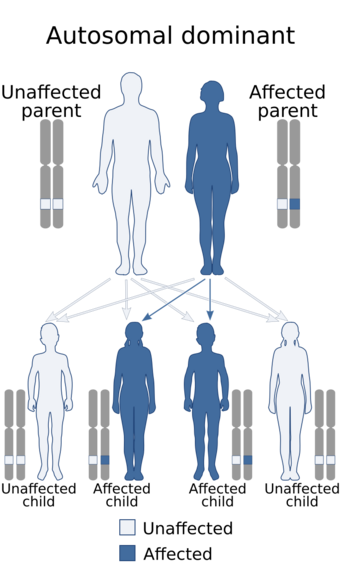Medicine:Cornea plana 1
| Cornea plana 1 | |
|---|---|
| Other names | Autosomal Dominant Cornea Plana, CNA1. |
 | |
| Cornea plana 1 is inherited in an autosomal dominant manner. | |
| Specialty | Ophthalmology |
Cornea plana 1 (CNA1) is a congenital disorder that causes the cornea to flatten and the angle between the sclera and cornea to shrink.[1] This could result in the early development of arcus lipoides, hazy corneal limbus, and hyperopia.[2] Cornea plana 1 is an autosomal dominant disorder.[3]
Signs and symptoms
Cornea plana commonly presents as a flat cornea, early-onset arcus lipoides, low anterior chamber depth, and an indistinct border between the sclera and cornea due to a decreased angle between the two.[2] Although a small corneal diameter is anticipated, measuring it can be challenging because the scleral tissue overlaps the cornea by a few millimeters. In the patients who have been described, the anterior chamber depth has been found to vary from 0.8 to 2.1 mm.[3]
Moreover, high hyperopia, strabismus, microcornea, posterior embryotoxon, iridocorneal adhesions, iris lumps, iris wasting, and pupillary abnormalities can all be present.[4] Instead of hyperopia, myopia has been identified in a few cases.[5] As many as 90 percent of cases have a bilateral presentation, which is linked to sclerocornea.[1] Finally, congenital ptosis has also been reported, and the absence of corneal protrusion is most likely the cause.[3]
Diagnosis
Clinical presentation, keratometry,[5] pachymetry, and endothelial imaging are used to make the diagnosis.[6]
Since the decreased refraction in the autosomal recessive form is more severe than in the autosomal dominant form, corneal refraction measurements can be used to differentiate between CNA1 and CNA2.[3]
Histology is distinguished by acanthosis, keratinization of the corneal epithelium, Bowman's membrane defects, and stromal vascularization and scar formation.[7]
See also
- Cornea plana 2
- Keratoglobus
References
- ↑ 1.0 1.1 Sutton, Gerard; Lawless, Michael A; Rogers, Christopher M (1995). "Cornea plana". Australian and New Zealand Journal of Ophthalmology (Wiley) 23 (1): 74–75. doi:10.1111/j.1442-9071.1995.tb01651.x. ISSN 0814-9763. PMID 7619462.
- ↑ 2.0 2.1 Tahvanainen, E; Forsius, H; Kolehmainen, J; Damsten, M; Fellman, J; de la Chapelle, A (February 1, 1996). "The genetics of cornea plana congenita.". Journal of Medical Genetics (BMJ) 33 (2): 116–119. doi:10.1136/jmg.33.2.116. ISSN 1468-6244. PMID 8929947.
- ↑ 3.0 3.1 3.2 3.3 Forsius, Henrik; Damsten, Margareta; Eriksson, Aldur W.; Fellman, Johan; Lindh, Sinikka; Tahvanainen, Esa (1998). "Autosomal recessive cornea plana. A clinical and genetic study of 78 cases in Finland". Acta Ophthalmologica Scandinavica (Wiley) 76 (2): 196–203. doi:10.1034/j.1600-0420.1998.760215.x. ISSN 1395-3907. PMID 9591953.
- ↑ Aldave, Anthony J.; Sonmez, Baris; Bourla, Nirit; Schultz, Gerald; Papp, Jeanette C.; Salem, Andrew K.; Rayner, Sylvia A.; Yellore, Vivek S. (2007). "Autosomal Dominant Cornea Plana is not Associated with Pathogenic Mutations inDCN, DSPG3, FOXC1, KERA, LUM,orPITX2". Ophthalmic Genetics (Informa UK Limited) 28 (2): 57–67. doi:10.1080/13816810701351321. ISSN 1381-6810. PMID 17558846.
- ↑ 5.0 5.1 Fogla, Rajesh; Indumathy, Thazethaeveetil R. (2020). "Customized toric intraocular lens implantation in cornea plana". Journal of Cataract and Refractive Surgery (Ovid Technologies (Wolters Kluwer Health)) 46 (12): e11–e14. doi:10.1097/j.jcrs.0000000000000350. ISSN 0886-3350. PMID 32818351.
- ↑ Ramappa, Muralidhar; Achanta, Divya Sree Ramya; Mohamed, Ashik; Chaurasia, Sunita (August 18, 2020). "Corneal endothelial alterations in Recessive Cornea Plana: a report of 4 patients and review of literature". Ophthalmic Genetics (Informa UK Limited) 41 (6): 659–662. doi:10.1080/13816810.2020.1804944. ISSN 1381-6810. PMID 32811257.
- ↑ Sigler-Villanueva, Aldo; Tahvanainen, Esa; Lindh, Sinikka; Dieguez-Lucena, Jose; Forsius, Henrik (1997). "Autosomal dominant cornea plana: Clinical findings in a Cuban family and a review of the literature". Ophthalmic Genetics (Informa UK Limited) 18 (2): 55–61. doi:10.3109/13816819709057116. ISSN 1381-6810. PMID 9228241.
Further reading
- Khan, Arif O. (2012). "Cornea Plana". Genetic Diseases of the Eye. Oxford University Press. pp. 85–91. doi:10.1093/med/9780195326147.003.0006. ISBN 978-0-19-532614-7.
- Coleman, Michael (2018). "Cornea Plana". Encyclopedia of Ophthalmology. Berlin, Heidelberg: Springer Berlin Heidelberg. pp. 513–514. doi:10.1007/978-3-540-69000-9_779. ISBN 978-3-540-68292-9.
External links
| Classification | |
|---|---|
| External resources |
 |

